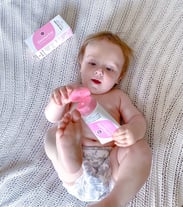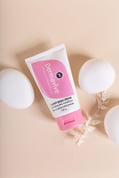
Did you know? 1 in 3 babies and toddlers experience nappy rash. It's a common yet commonly misunderstood area of infant health.
To help you ease your child's nappy rash woes, we have busted some popular nappy rash myths.
MYTH #1: Buy bigger nappies to avoid friction
Buying a nappy that is too large for your baby with the hope of reducing friction won’t solve your nappy rash problems. Instead, you may risk leakage and discomfort as your baby experiences discomfort from the bulk of a bigger nappy.
Tip: Always look at the weight range of the nappy. As your baby reaches the higher end of the weight range, then is the time to explore a larger nappy.
MYTH #2: Certain nappies cause nappy rash
While yes, the environment of a nappy can cause and exacerbate nappy rash, the materials themselves won’t be the leading cause. While it may be tempting to explore endless options and brands, most nappies are highly absorbent and made from minimally-irritating materials. If your baby is prone to nappy rash there are other ways to reduce its occurrence than switching brands.
Tip: Offer your baby nappy free time whenever possible. Lay them on a towel and allow them to enjoy a break from wearing a nappy. This gives your baby’s skin time to heal without the moist environment of a nappy.
MYTH #3: Baby powder is a must
Baby powder has long been used to soak up excess moisture. While baby powder has had its own controversy, the formula has evolved over time. However, there are less messy, more conventional options on the market.
Tip: A barrier cream will prevent moisture build-up, while providing your baby’s skin with a protective layer from ammonia in urine and the bacteria in faeces. A thick nappy rash cream which contains anti-inflammatories such as colloidal oatmeal will also provide the skin with healing and soothing benefits. Use it at every nappy change to protect and heal inflamed skin.
MYTH #4: Cloth is best
For the environment – yes! However, disposable nappies have come such a long way. There are plenty of organic, chemical-free options which are designed to provide your baby with the same support and comfort as cloth.
Tip: If you are environmentally conscious, cloth nappies are a great alternative to disposable. They may not reduce the likelihood of nappy rash; however, they are much better for the environment and your wallet!
MYTH #5: All rashes are created equal
A nappy rash may appear due to a number of reasons, including friction, exposure to ammonia in urine as well as diet. Aside from infant thrush, a not so commonly known cause of a rash in the nappy region is hand, foot and mouth (HFM). While it presents on the hands, feet and mouth, it can also rear its head in the nappy area and be very uncomfortable.
Tip: If your baby presents with a persistent or blister-like rash see your doctor to explore the possibility of infant thrush or HFM.
Dermavive Nappy Rash Cream contains a range of natural ingredients designed to sooth inflammation caused by nappy rash. It also creates a barrier between the skin and the nappy to reduce exposure to ammonia and bacteria. This cream encourages healing, reduces inflammation and protects infant skin with a thick application.

Dermavive Nappy Rash Cream is a dermatologically endorsed pH balanced cream designed to protect against irritants, prevent moisture build up and calm irritated and inflamed skin.
Ready to say goodbye to red, inflamed skin and reduce nappy rash for good? Purchase your Dermavive Nappy Rash Cream here.